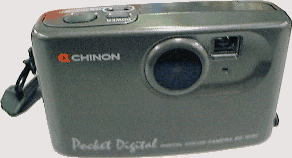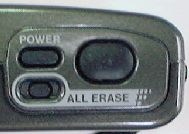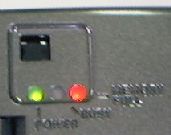What's ES-1000?
[Japanese]
[English]

Updated December 29, 1997.
ES-1000 is a digital camera with the following features:
Below I will explain these and some other characteristics.
Weight and size
Here are the metrics of ES-1000:
- Size:
- 100x30x60mm (= 3.9x1.2x2.4inch)
- Weight w/o battery:
- 110g (= 3.9oz)
You can see that it is very compact and light.
In addition, unlike many other digital cameras that use several
AA-batteries, ES-1000 runs on a single lithium battery called CR123
which weigh only 16g (= 0.6oz); so its weight including battery does
not differ much from that of a single-use camera.
Price
The list price of ES-1000 in Japan is 39,800Yen (about US$300). Its
street price has been 10,000-20,000Yen as of early 1997, but currently
it is hard to find. DC-20 is sometimes liquidated
at less than 10,000Yen.
Picture quality
According to the catalogue, the image resolution of ES-1000 is 493x383
pixels in fine mode. In fact, its pictures look so good that their
quality is often evaluated in magazine articles as being above that of
other cameras on the same price range or even near to that of 640x480
products.
However, resolution of raw images that are transferred from ES-1000 to
PC or Mac is 512x243 pixels (each pixel consists of 8 bits) and not
493x373. The driver software seems to remove several invalid pixels
on the top/bottom/left/right borders, and to perform vertical
interpolations to produce 493x373 images. I suppose that the reason
why images are good enough after this interpolation is that it doesn't
compress images using JPEG (as many other cameras do) but sends raw
CCD data for image processing on PC or Mac.
Picture memory
ES-1000 can store only
- 8 images on fine mode or
- 16 images on normal mode,
which is indeed too few.
To cope with this shortcomings, an option called memory card holder is
available. It is small and light but doesn't accept standard ATA
flash cards (only AIMS flash cards for digital cameras can be used on
them). Alternatively, you can immediately transfer pictures if you
take a notebook PC with you. However, the driver software that comes
with ES-1000 works only on Windows 3.1/95 or Mac. I wish I could use
it on my handy HP200LX!
... that is what I have been wishing. If you have the same wish, you
should try a software called
LXDC by
Eiichiroh Itoh.
It is explained in detail on the separate page
here.
Besides LXDC, there is a DOS command line program called
MCH
by NAKAMURA Takahiro.
Optical specs
ES-1000 has no flash, but images taken in a dim place such as
restaurants look not too bad (though their colour may become somewhat
inaccurate). You may also try
Flash Kit for DC-20
(I am not sure if it can be used with ES-1000).
Focus is not AF but pan focus from 0.5m to infinity. Practically you
can take pictures if you are at least 30cm (= 1ft) away from the
subject.
As LCD display is not available, you have to use the optical finder
whose parallax is fairly big; you should deliberately shift the
composition if your subject is less than 2m (= 2yd) away.
User operation
 The operation of ES-1000 is extremely simple. It has only three buttons:
The operation of ES-1000 is extremely simple. It has only three buttons:
- Power switch
- Shutter button
- Erase button
The form of each button is unique enough to avoid misoperation.
 Its status is expressed with three LEDs:
Its status is expressed with three LEDs:
Number of remaining pictures you can record is shown by number of
blinks. Magazine articles say that this method is difficult to
understand, but I was quickly used to it.
Differences from DC-20
The catalogue specs of ES-1000 and Kodak DC-20 are exactly the same.
Their external appearances are also common except their colour and
logo. The only difference currently known to us is a code transmitted
during communication that is supposed to be product ID; they seem to
be at least highly compatible including their firmware.
However, software that come with them are very different. The driver
of ES-1000 has a capability to store raw images transferred from
ES-1000 to files in so-called CMT format and to read them later to
convert it to other image formats. Size of a CMT file is 122KB,
which makes it convenient for saving original images in uncompressed
form.
DC-20 software cannot handle this CMT file, but instead it includes
application software to make cards, calendars or slide shows.
The
official ES-1000 driver distributed online by Chinon used to work
with DC-20, but I have received several disappointing reports that
current version does not work correctly with DC-20.
Power supply

CR123 and a 10Yen coin |
ES-1000 uses a lithium battery called CR123 (or DL123A), which is
light as stated above and easy to find becase it is commonly used in
cameras. I was able to take and transfer around 100 pictures with one
CR123. The price however is slightly too high (480-800Yen in Japan).
The list price of the optional AC adapter for ES-1000 is 4,500Yen,
which is high enough for tempting people to conspire soldering a junk
AC adapter to an appropriate connector. However, as one can
immediately notice, ES-1000 has no jack for AC adapters --- to use the
official AC adapter, you have to remove the battery and to insert a
connector which has the shape of a CR123 battery; you would better
continue buying CR123s.
|
Pictures on this page is taken using Fujifilm DS-7 (as I don't have
two ES-1000s :-)).
Please send questions and comments about this page to
hideki@teikan.net.
 Its status is expressed with three LEDs:
Its status is expressed with three LEDs:

 The operation of ES-1000 is extremely simple. It has only three buttons:
The operation of ES-1000 is extremely simple. It has only three buttons:
 Its status is expressed with three LEDs:
Its status is expressed with three LEDs:
